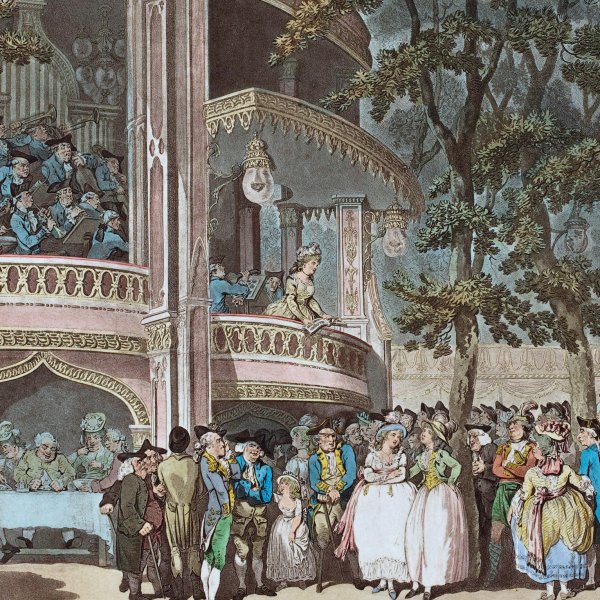Pleasure Gardens of London

Worgan - To Fly Like Bird
Sunday, September 23, 2018, Gore Place, Waltham
Overture to Artaserse Johann Christian Bach (1735-1782)
Allegro do molto • Andante • Presto
In This Shady Blest Retreat J. C. Bach
Ariel’s Song Thomas Arne (1710-1778)
To Fly Like Bird John Worgan (1724–1790)
Cuckoo Concerto John Fredrick Lampe (1702-1751)
Vivace • Adagio • Allegro
The Morning Arne
See the Kind Indulgent Gales J. C. Bach
Hornpipe for the Concert at Vauxhall George Frideric Handel (1685-1759)
Hush, Hush, Ye Pretty Warbling Quire Handel
From Organ Concerto no. 5 in D Major James Hook (1746-1827)
Rondo (Allegro)
The Lass of Richmond Hill Hook
Teresa Wakim, soprano
Suzanne Stumpf, traverso; Heloise Degrugillier, traverso and recorder
Elisabeth Axtell and Jane Sebring, natural horns
Sarah Darling and Jesse Irons, violins
Marcia Cassidy, viola; Daniel Ryan, cello; Jay Elfenbein, Baroque bass
Michael Bahmann, organ
Program Notes
Beginning in the seventeenth century, it became fashionable in the summer for Londoners to escape the bustle of the city by seeking the rural calm of the parks and gardens located on the city’s outskirts. By the early eighteenth century, music and other entertainments began to be introduced at these gardens, growing into nightly presentations offered throughout the summer months. In 1728, an entrepreneur named Jonathan Tyres took over the lease of Vauxhall Gardens and made it the most popular location for these summertime diversions.
The gardens at Vauxhall featured long, tree-lined promenades and several buildings and pavilions of exotic architecture. The public could dine and enjoy all manner of entertainments such as acrobatic shows and fireworks, but most especially music. With Enlightenment thinking giving rise to the public concert, Tyre’s admission price of one shilling meant that Vauxhall could offer one of the only public performances accessible to people of all walks of life. Tradesmen could rub elbows with nobility here, as could prostitutes and pickpockets! The orchestra performed in an elevated bandstand, although later in the century, rotundas and indoor rooms were built in response to the fickle English weather. Later in the eighteenth century, similar pleasure gardens were organized in other parts of England, on the European continent, and even in New York and Charleston.
The musical repertory of the London pleasure gardens initially consisted of instrumental works, with concertos by Handel figuring prominently. Testifying to his importance, a statue of Handel by Roubiliac was prominently placed at Vauxhall in 1738. By the second half of the century, the programs tended to comprise a first half of more “serious” symphonies and concertos, followed by a second half given over to lighter vocal works of bucolic, amorous, or pastoral themes. In fact, a specific repertory of “Vauxhall songs” became popular, the principal composers of which were native Englishmen such as Arne, Hook, and Worgan. These “Vauxhall songs” also launched the careers of English singers who, in the genres of opera and oratorio, had been mostly passed over in favor of Italians.
In 1762, Johann Christian Bach, the youngest son of Johann Sebastian, came to England in response to an invitation by the management of the King’s Theatre in London. He had intended to only stay in England for a year, but remained there until his death in 1782. His first published works in England were the Six Favourite Overtures, which were compiled from operas he had recently written during his stay in Milan. Bach soon wrote music for the gardens, including several collections of Vauxhall songs published between 1766 and 1777, two of which we include on this program. All of his Vauxhall songs feature unusually full and varied orchestrations and a bravura vocal style.
Two of the most prominent musical directors at the London pleasure gardens were also their most prolific composers: James Hook and Thomas Arne. Hook enjoyed a long career as director at Vauxhall spanning forty-five years. He is said to have performed an organ concerto every night, the total of which amounted to thousands of performances! His most popular song, The Lass of Richmond Hill, arguably the most famous song of this entire repertoire, epitomizes the light-hearted, strophic ballad style that was all the rage at that time.
Thomas Arne had a long association with the theatre, particularly with Drury Lane, where he composed and produced masques, operas, and incidental music from 1734 through the 1760s. Arne’s talent for charming character portrayal is much in evidence in Ariel’s Song, taken from his incidental music for Shakespeare’s The Tempest, and in his vivid musical portrayals of a sunrise and the singing of the lark in his cantata The Morning.
John Frederick Lampe was a German-born composer and bassoonist who immigrated to England where he became a leading composer of English opera. He married his leading lady, the singer Isabella Young in 1738 (a popular Vauxhall soloist), becoming Thomas Arne’s brother-in law as Arne was married to Isabella’s sister Felicia, also a prominent Vauxhall singer. Lampe’s Cuckoo Concerto is a work that, especially in its third movement, effectively and humorously uses the cuckoo’s call. It has come down to us in the form of a keyboard short score, with the solo line in the upper staff and a figured bass in the lower staff. This source lists Lampe’s original instrumentation as flute, strings, and continuo, inspiring the ensemble to create a reconstruction of the original version modeled on other concerto orchestrations of the period. This work is included on our recently released CD Earthly Baroque.
—Daniel Ryan and Suzanne Stumpf
